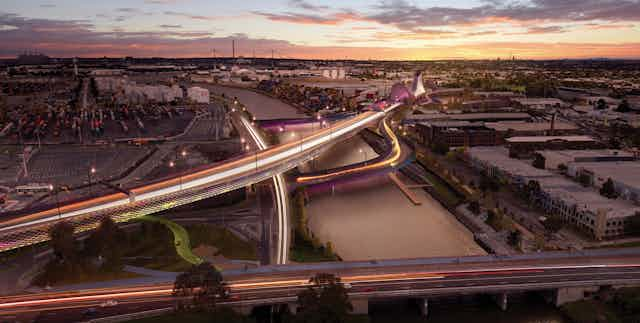The recently released environmental effects statement and transportation impact assessment for the proposed West Gate Tunnel project in Melbourne’s western and inner suburbs have once again sparked debate about the future of mobility in Australian cities, and the ability of large road projects to provide it.
In the environmental effects statement, the assumptions behind the models on the need for the tunnel might paint a gloomier picture of the future than is warranted. Many are not inevitable and are, in fact, within the control of the state government and Melburnians.
Why we should be wary of the forecasts
The figures in the transport impact assessment are calculated using a traditional four-step model.
Given the purpose to which the model has been put in this case, it is unsurprising that it predicts traffic chaos across metropolitan Melbourne in 2031. Also unsurprisingly, the modelling indicates that the West Gate Tunnel would ease this chaos.
Comparing the “build” and “no-build” scenarios, both set in 2031, 28,000 fewer vehicles per day would use the congested West Gate Bridge if the tunnel is built. As it is designed to, the modelling presents a clear argument to build the tunnel.
There are numerous reasons to be suspicious of the modelled outcomes. For one, these models are notoriously unreliable.
Research shows that half of road project forecasts are incorrect by more than plus or minus 20% after one year of operation. And for toll roads like the proposed West Gate Tunnel, the average observed error is 23% fewer vehicles using the road than forecast.
Second, the extra 28,000 vehicles on the West Gate Bridge in the no-build case are not real cars; they are artefacts of the transport network assumptions. These assumptions feed into the models to create the build and no-build scenarios.
The models predict a 48% increase in road traffic in 2031 and a 100% increase in public transport traffic. The transport impact assessment is relatively silent on the implications of this assumption about public transport patronage.
Cases built on pessimism bias
Studies indicate this 48% increase might be subject to “pessimism bias” – that is, a tendency to imagine the worst. A 2015 analysis found that in 70% of 35 transportation projects in Denmark and England actual travel demand did not reach the end-of-period forecast levels when the projects were not constructed.
Pessimism bias is a product of how the models understand historical road construction and traffic growth. It is likely present in the West Gate Tunnel proposal – but this cannot be measured as yet.
The 2031 build and no-build cases both incorporate an extensive program of road network construction and expansion apart from the tunnel, which is standard practice. This includes 100 kilometres of additional motorway lanes in the CityLink and Western Ring Road widening projects. Both roads feed into the tunnel.
VicRoads’ outer suburban arterial roads program includes an additional 700km of arterial roads, which feed into Melbourne’s greater road network. If these roads are not all built then the forecast will be incorrect.
Also, the annual traffic growth rates used in the models are primarily based on historical observation. From 1996 to 2016, traffic volumes across Melbourne grew by 2.6% annually. The model assumes this growth will continue.
This period of growth includes the construction of the EastLink and Peninsula Link toll roads and several outer suburban arterial roads. Because the construction of roads promotes new traffic, these programs partly explain the growth from 1996 to 2016.
Consider the alternatives
The “need” for the tunnel exists only because of the presence of extra road and motorway capacity in the modelling assumptions – and because of the absence of any estimates of the effect on car travel of improved public transport passenger and freight transport alternatives in Melbourne’s rapidly expanding western suburbs.
The package of roads that will generate traffic growth on the West Gate Bridge and in the proposed tunnel have not yet been built, and there is nothing inevitable about any of it. Melbourne’s East-West Link and Perth’s Roe 8 both demonstrate that public resistance is not necessarily futile.
The government and Melburnians have a choice about how we build our cities. We can perpetuate the “need” for roads by continuing to build banal infrastructure, such as large suburban arterials or excessive car parking. This would create the conditions for roads like the West Gate Tunnel – or we could insist on something better.

